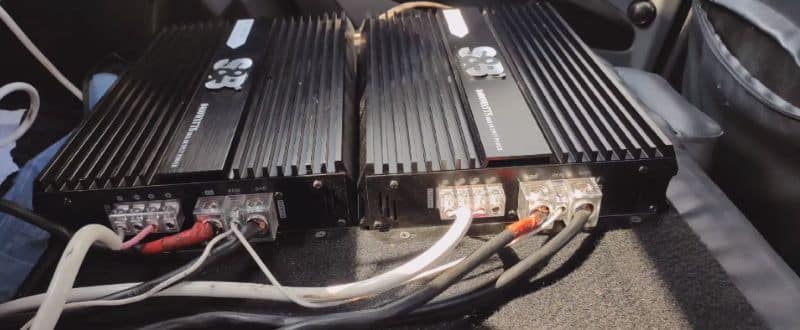If you find your monoblock amp is lacking juice to power your subs and wonder how to bridge a monoblock amp, then you are probably on the wrong foot.
It is not technically possible to bridge a mono amp because it does not have the additional channel needed to bridge with. But there is an alternative to the power problem. You can join the two mono amplifiers to act as one, sharing their power and efficiency.
Now, in the following parts, I will see how to bridge 2 mono amps together or, in other words, how to strap them to solve the amp’s power shortage.
In This Article
What Are the Differences Between Bridging and Strapping?
Car audio enthusiasts often wonder how to bridge two amps together, but what they really mean is whether they can strap them.
The confusion often arises because the term can be misleading. When people hear 'bridging,' they usually think of increasing power, which is not incorrect, but that doesn't apply to mono amps. Let's understand the differences between bridging and strapping with an example.
Think of them as two ways to supercharge your sound system. Bridging is like a teamwork strategy for amps. In a stereo amp with two channels, bridging means these two channels hold hands to produce more power together than they could alone. But in a monoblock amp, there's only one channel. It's already giving its all, so there's no teammate to join forces with. This is why you can't bridge a monoblock amp – it's a solo player!
On the other hand, strapping is a process used with monoblock amps. When two identical monoblocks are linked, they function as a unit to provide one speaker with the same amount of power. It sounds smoother and more powerful, like two engines at a perfect time in your favorite race car. Both techniques add that extra kick to your music but in different ways.
How to Strap 2 Mono Amplifiers for Car
If you are looking to boost the power of your audio system but only have monoblock amps, what you can do is strap them.
In car audio systems, strapping is a technique used to connect two identical amplifiers to increase the power output to a single subwoofer or speaker. This method uses two tiny amplifiers instead of one larger amplifier to effectively double the power.

How to Wire To Mono Amps Diagram
Let’s see a step-by-step guide on how to strap 2 amps together.
Step 1: Choosing Identical Amplifiers
To strap amplifiers, it is mandatory that you use two identical amplifiers. They must be the same model, and make sure they support strapping. You could also search the amp’s body for a master and slave switch. If you see one, your amp probably supports strapping. I recommend you read the owner’s manual if you are confused.
Step 2: Deciding upon the Master and Slave Configuration
When amplifiers are strapped, the primary amp “MASTER” controls the secondary amp “SLAVE."
It means you only need to tune the MASTER amplifier, as its settings will be replicated on the SLAVE amplifier. This setup is more manageable than trying to tune two separate amps individually.
Also, strapping allows the flexibility of upgrading your system by adding another amplifier rather than replacing the existing one.
Now, do the following.
- From the master amplifier, take an RCA cable from the 'bridge out' and connect it to the 'bridge in' on the slave amplifier.
- Connect the main signal RCA cables from your head unit to the Master Amplifier.
- Some amplifiers have a switch to designate them as master or slave. If your amplifiers have this switch, set one to 'master' and the other to 'slave.'
Step 3: Connecting the Speakers to the Amplifiers
When connecting the subwoofer, you'll be dealing with the speaker terminals on both amplifiers. The objective is to make sure that one amplifier's output complements the other, essentially making them act as a single, more powerful unit.
Jumper Wire for Negative Terminals:
Start by taking a jumper wire (a short piece of speaker wire will do) and connect the negative (-) speaker terminal of the master amplifier to the negative (-) speaker terminal of the slave amplifier. This wire essentially bridges the two amplifiers together at their negative terminals.
Positive Terminals to Subwoofer:
Next, you will connect the subwoofer to the positive (+) terminals. Take another speaker wire and connect one end to the positive (+) terminal of the master amplifier. The other end of this wire goes to the positive (+) terminal of your subwoofer. Then, take a third speaker wire and connect one end to the positive (+) terminal of the slave amplifier, with the other end going to the negative (-) terminal of your subwoofer.
Step 4: Hooking up the Remote Turn-On Wire
The remote turn-on wire is crucial as it signals the amplifiers to power on or off with your car's stereo system. This avoids the need to manually switch the amplifiers on and off.
Using a Jumper Wire:
You can use a jumper wire to interconnect the remote terminals of both amplifiers. First, connect one end of the jumper wire to the remote terminal (often labeled "Rem" or "Remote") on the master amplifier. Connect the other end of this jumper wire to the corresponding remote terminal on the slave amplifier.
Alternative Methods:
As an alternative, you could run a separate remote wire from the head unit to each amplifier. Another method is to use a relay that's triggered by the head unit's remote output, which then sends a signal to both amplifiers. This can be a better solution if the head unit has a limited current capability on its remote output.
Step 5: Hooking up the Power Connection
You will need to connect both amplifiers to your battery, including the positive and ground connections.
Ensure that both amplifiers are properly connected to a power source. This typically involves running a power wire from the battery of your vehicle to each amplifier. It's advisable to use a distribution block for this purpose. The distribution block effectively splits the main power wire coming from the battery into multiple outputs, allowing you to connect each amplifier separately. This setup ensures that each amplifier receives the necessary power without overloading a single wire.
Also, it's essential to connect the ground wires from both amplifiers to a common grounding point in your car. This point should be a bare metal area that's free of paint, rust, or dirt, as a solid ground connection is vital for the system's performance and safety. Poor grounding can lead to noise in the audio system and potentially damage the amplifiers.
Power Output and Impedance Considerations
When strapping two car amplifiers together, a key aspect to understand is how it affects power output and impedance handling. Strapping essentially means running two amplifiers as if they were a single unit. Suppose you have two amplifiers, each capable of delivering 1000 watts at 1 ohm. When strapped, their combined power output increases to 2000 watts. However, this increase in power comes with a change in the minimal impedance they can handle together.
Individually, each amplifier can drive a load at 1 ohm, but when strapped, they can only handle a minimum of 2 ohms together. This is because the load is effectively distributed between the two amplifiers. In practice, this means while the overall power (wattage) available to your system is increased, the amplifiers cannot operate at the lower individual impedance they could handle when operating separately. This balance between increased power and altered impedance handling is crucial for optimizing the performance of your car audio system when strapping amplifiers.
Closing Remarks
In our example, I showcased the use of monoblock amplifiers as they are popularly used for strapping. Now that you know all the essentials on how to bridge a monoblock amp, you can create that extra kick your subs were lacking.
The primary reason for strapping amplifiers is to power a single subwoofer voice coil with multiple amps, effectively doubling the power. The process of strapping 2 amps together is easy to follow, and you can mimic that for any configuration as long as they support master-slave mode.

My passion for automotive mechanics began in my father’s garage. Today, I co-own a local car service agency and write for CarAudioHunt to help readers with car audio and vehicle upgrades. With years of hands-on experience, I offer expert guidance for both DIY enthusiasts and beginners.
